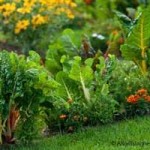
Compost Bin at Community Garden in Ferndale
By Catherine Haug, May 24, 2016 (photo, right, by C. Haug)
Since the dawn of agriculture – if not before – humans have returned ‘waste’ foods to the earth, to feed the earth and keep it whole. But in the late 1800s, feeding and protecting the earth was shoved into the background, and by mid 20th century was all but forgotten by modern society, especially in the US. Instead, it all went into landfills, combined with other waste – out of sight, out of mind – where it takes much much longer to break down.
Tilling the soil, which breaks up and murders the soil’s microbiome, weakening its ability to help plants thrive. The Great Dust Bowl in the 1930s may have been started by drought, but it was fueled by the tilled soils on the Great Plains.
The manufacture of chemical fertilizers (see my post Organic vs chemical fertilization for farms, gardens for more), using ‘fixed nitrogen’ originally made from petroleum to produce bombs for the war, pretty much sealed the casket of those dying soils. Our great American carbon sink has turned into a wasteland that produces food only through the use of ag-chemicals, and that food is sub-par nutritionally.
But it’s not too late to fix the harm we’ve done. “…a single one-half-inch dusting of compost on rangeland can boost the soil’s carbon storage for at least 30 years.” (1,2) Read on for more about this. (more…)



